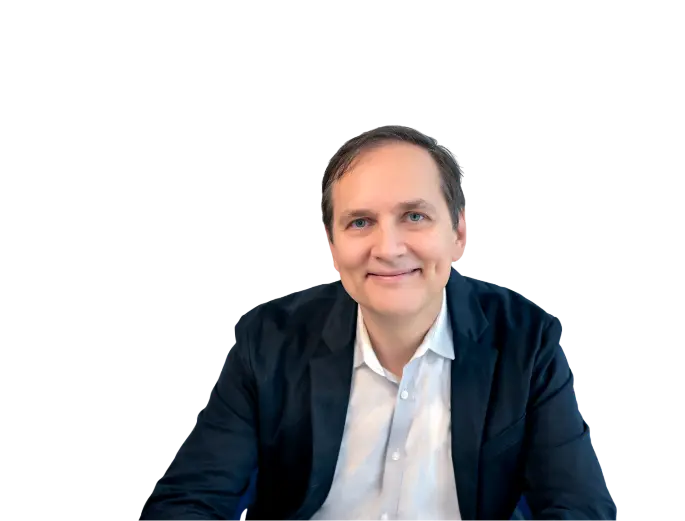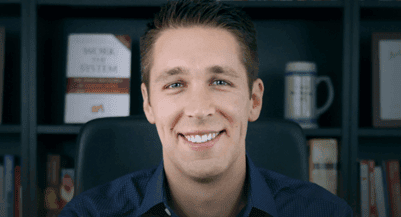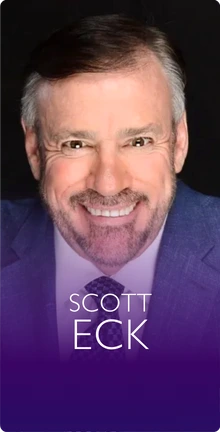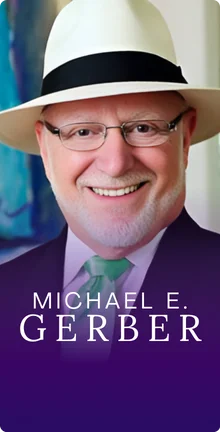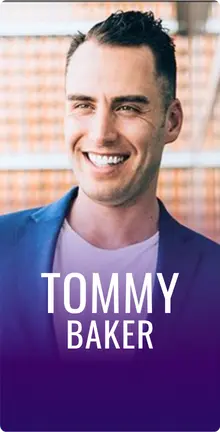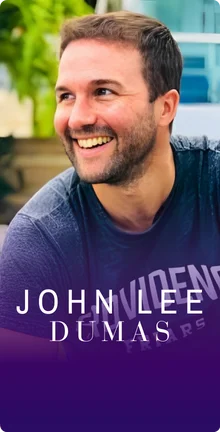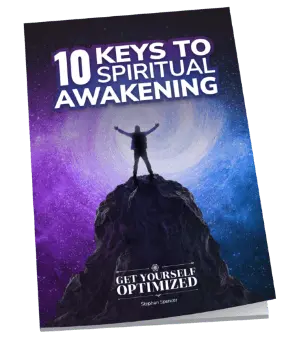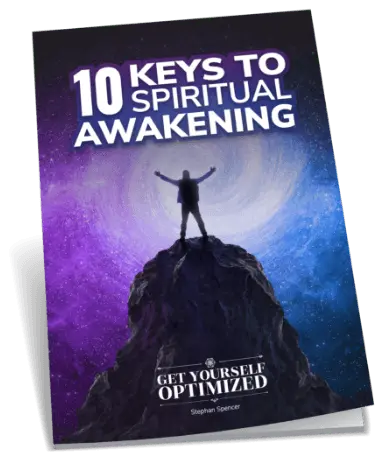Excited to be here.
Let’s talk about working the system and what the heck does that even mean because if we’re talking about productivity, getting stuff done, getting things done, GTD, we’re talking about what productivity is and my priority is all about productivity. But what is working the system and how does that relate to productivity
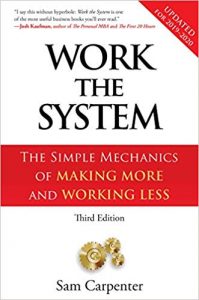
Great question. It’s based on my business partner’s book which is called Work the System. To be honest, I wasn’t super excited about the title when we first started working together because I figured it was kind of like a connotation for doing something sneaky or doing something that was illegal or against the government.
But when Sam, my business partner, explained it to me, it’s very logical and he has kind of an engineering mind. His idea was that you have these systems in your life, and you want to work on them, and you want to work in them. If you’re smart and efficient, you’re going to work your systems. You’re not going to let things happen to you; instead, you’re going to be in control. His book and his method and what we teach are all about getting in control of your systems instead of just going to be a fire killer your whole life.
How did you end up finding Sam and deciding to work together?
I try to keep the story somewhat short, but I’ve been a business consultant flying around way too much for my family’s sake, helping flooring store owners. Think of Carpet One and Flooring America, they’re no small businesses. They’re typically doing $3 million in sales and they have a lot of similar problems to each other. So, I’d fly around from each location to help them with their sales, marketing, leadership, merchandising, pricing, and the way they stock their warehouse. You name it, we worked on those particular problems and I was just getting pretty burned out with it.
I met Sam in Bend, Oregon. We both used to live in Bend, Oregon and we met at a coffee shop. I pitched him on a new business idea and a concept I was working on. I wanted to start my own company. It was similar to Visiting Angels. For those people who are familiar with the elderly population and how they need help at home, I was working on that concept and all of the signs point to baby boomers needing that kind of assistance. I thought I could jump into that and grab the wave because one of the key elements for the secret to success is starting a business in a soft market. A market where there’s more demand than there is supply. That was my plan to go into that market.
He was looking at my business plan and he’s like, “Don’t do it, Josh. You’re crazy.” I said, “What are you talking about? I think this is a great idea. Everyone else is giving me positive reinforcement.” He said, “No. You’d probably get divorced. It’s going to be like herding cats. You’ll hate it, so just don’t do it.” Anyway, I was kind of surprised by his honesty and bluntness but that’s one of his attributes. He’s really sharp and honest. I pursued it for several more months.
While I was pursuing that, he came back to me. His book was just being released. I think it was the second edition of his book. His book has been out there for 11 years and people can pick it up for free at WTS Enterprises. He was starting to get interested. Interest in people wanting coaching, consulting and help in getting their business organized.
He’s 69 right now, but back then—eight years ago—he didn’t want to do the work. He didn’t want to do any coaching and consulting. He didn’t want to travel. He didn’t need the money. So he said, “Hey, Josh. How about you help me out with this? Let’s see how you do.” And so that was what happened about eight years ago. I started working with some of the clients who were interested, and we just became good friends and hit it off. The rest is history.
Change your reality by changing your mechanics. Share on XThat’s great. I have to share a little bit of feedback about the book and the process, the methodology that is in the book, and how much of a game-changer it’s been for a client and friend of mine. His name is Benjamin and he has told me that for one thing, he read the book for a second time because it was so good. He told me it was really helping him get his S-H-I-T together and grow his business.
One thing that floored me was that he was getting tons more out of that book than Getting Things Done. I’m a huge fan of Getting Things Done by David Allen. David’s been on the show. His methodology, GTD, has been game-changing for me. I’m not familiar with Work the System methodology and systems but that really intrigued me and that’s why my team contacted you to have this interview because that really caused me to stop and pay attention.
Well, good. Getting Things Done is a great book. The E-Myth is a great book. There’s a lot of great books on businesses and getting them organized.
By the way, The E-Myth is a great book and Michael Gerber has also been on the show. A completely different kind of idea or thought process around that like starting up a new company instead of trying to fix your existing business and everything. Also, a game-changing book, but I want to know, what is the magic? What is the secret sauce in the Work the System book that makes it so impressive to Benjamin and potentially, for our listeners?
I think the secret, and it’s not mystical or metaphysical or spiritual but it’s this new perspective or a new way of seeing your world. For a lot of entrepreneurs, they don’t see the forest for the trees. They get stuck in doing the work.
A big part of the book’s first section is changing your mindset which has to do with getting outside and slightly elevated kind of looking down on yourself and your business. Seeing the separate processes, systems, and repeatable things that happen all throughout your business and being able to isolate, identify, and set them aside. Then, start to work on them. And have a specific methodology— what we teach and how to work with those systems, how to document them, how to optimize them and how to use them for delegation and cross-training and scaling your business.
I think a lot of people, they like the idea of putting systems in place but they just don’t have a framework so that’s what we teach. A lot of our clients say it’s like part two to E-Myth that had their paradigm shifted but then they’ll say, “How do I do this?” And we have the mechanical steps in the book. What I’ve done over the last eight years is codified in the different programs to make sure you don’t just think about the idea, but you actually do something with it and put those mechanical pieces into place.
What would be some of those pieces? I’m imagining there are many different checklists and standard operating procedures and stuff. Walk us through an example of one of these.
Definitely. We have a few pillars that every company goes through whether you’re a solopreneur or you’ve got thousands of employees. We’ve worked a wide range, but they have to start off with first getting everyone to have the same mindset. We get that in terms of this called Work the System Mindsets. That’s the first thing. Everyone needs to understand that first. That can take an instant.

Then, it’s the pillar one which is this strategic objective. A lot of companies have vision, values, mission. They might have a five-year plan. But we build what we call a strategic objective which is a one-page document that lays out exactly what is going to be the focus for this business, the direction it’s going to go on, and how is it going to get there. It’s basically every single thing you can think of, crammed into one page, a really potent page so that whoever works with your business knows, “If I follow this strategy, I’m going to be successful.” It helps draw everyone together and helps them to stay on the same page. That’s the first pillar.
The second pillar is the operating principles. Those are decision-making guidelines. They’re basically for everybody who doesn’t have a process or procedure or specific checklist to do something. If they follow these decision-making guidelines or these beliefs or these values, they’re going to be successful. Operating principles are like, “This is not monopoly money. Treat it as if it was your own.” Or a principle might have to do with integrity. A principle might have to do with honesty. A principle might have to do with the way we maintain our equipment. They’re overriding, guiding principles.
The reason why these are so powerful is that usually, owners think that if they pass things off, they’re going to be done the wrong way. If you have this strategy in place, principles in place, anybody new who comes to your company can kind of read your mind. They know where you want to go. They know how you would make decisions about time, money, technology, people, relationships. These ideas have already been thought through and given some information behind them to make decisions.
The last thing is the procedures. The procedures take the place, like you said, checklist, guidelines, process outlines and how to document. This is where it becomes mathematical because the more of these you build, the more freedom you are building, the more ability to scale and the more efficiency happens. So we help companies go through the process.
I’ll say, it’s not always fun. We call it heavy lifting but week after week of extracting these things, applying them, optimizing them and measuring the results, we can pursue perfection. I think that’s the one thing that a lot of owners don’t have, big visions of what they can achieve. But once they get things out of their head and once they get some of these things documented, they realize that they can pursue their business on a whole another level because those bottlenecks are gone. The company is now based on a series of systems and processes and not based on how much work they can do by themselves.
Got it. Walk us through the process of when you’re working with a client, you’re spending X amount of time on each of these three pillars, what’s involved in getting all these in place?
I don’t want to say it depends, but it does, kind of. It depends on so many factors. If you’ve got multiple owners, multiple stakeholders, whether it’s a venture capital-backed business or it’s a startup. That’s why the framework is so simple. We can apply it to any business and it works but the nuance does matter in terms of what you want to accomplish in the end and where you’re starting off. Do you have a 10-year track record? So you know exactly where you systemize. Or it’s a new business and therefore you’ve got to be loose or fluid with your plan because it’s probably going to change a few times as you go about it.
When I do consulting and I fly out there, we try to get the strategic objective and operating principles done in day one. That’s really focused. That’s getting all the players involved. It’s trying to extract things out of their brain. It’s trying to push them towards, “Let’s just get the essentials done and move forward.”
Instead of dreaming and thinking about this for six months. We’re about action and speed, knowing that you can always tweak things and improve things a few weeks from now, a few months from now, a few years from now. It’s better to just make some action and move forward.
Your SOPs are the brain of your business as it stores everything. Share on XI mean, you can get those two documents done in a day if you really want to. But realistically, it’s going to take you a few weeks up to a month to get them fine-tuned, tweak, present it to your team, get them to buy in and get some other ideas and then start to make decisions based on them. But like any documentation, it’s completely valueless unless people follow it; they must make decisions based on it. Maybe they drop a business line because their strategy doesn’t fit with that or they fire someone because they don’t follow one of the principles of friendliness or something. You have to be willing to make changes; if you’re ready for a change. We only work with folks who want to make a change. If you don’t want to make a change, if you’re happy with how your company is running, you’re not going to be that excited to go through this exercise.
You’ve got the strategic objective, one-pager, and the operating principles done on the first day by working with you. It might take several weeks if you’re trying to do this on your own, which I imagine you can do if you just go and pick up a copy of the book. I’m also amazed that the book is free on your website. What’s the idea behind that? I don’t want to make my books free on my website. There’s a lot of work to create an amazing book, years potentially, to create an amazing book.
Our story is very fascinating. We got into the space, this business room and space, not on purpose. Sam wrote the first draft of the book just for his employees. He wasn’t trying to be a bestselling author. He wasn’t trying to have three editions. He just wrote it because he knew it would help his employees and maybe a few other folks. It’s really just grown organically with a cult following.
The other thing is he didn’t need any money from it. It wasn’t a money-maker either. It was just to get the message out to help as many folks as possible. He’s always had it for free. It’s got the audio version for free. You could buy it for $25 on Amazon but I think there’s been, I don’t have the exact number, I think it’s about 1.5 million people have downloaded it so far.
It’s out there and it’s helping a lot of folks. As you said, most folks, they just do it on their own which is great. We hear case studies of that all the time but for those who want help, they come to our site and then we help them out and help them make it happen.
Amazing. The audiobook is it narrated by Sam or by you?
He did it himself. Sam’s very passionate about his books. I could be wrong, but I don’t think anybody has spent more care and effort in a book than Sam has. Every couple of years, he goes back through it, he revises it, he updates it, he tweaks it. That book has gone through three editions but thousands and thousands of revisions to really get his points across and to get his message across. For me, I get to see it from the outside, it’s an amazing book now.
It sounds like a labor of love.
He loves it. Probably a couple of years from now, I’m sure he’ll go back to it again. He will add some new things, some new ideas, some new stories. He owns the rights to do that which is unique for an author. He’s not interested in writing 10 books. He’s just interested in having a really good book.
Cool. How long is the audio version of the book? How many hours?
I don’t know. It’d be a pure guess.
Listeners, definitely go and download the book. If you prefer listening to the audio, get the audio version. The price is right. You’d be silly not to partake in that. Once the strategic objective and the operating principles are done and now, you’re going through to the procedures, those process outlines, and SOPs, checklists, all that sort of stuff. What’s involved in there and I know it depends on the type of business, but let’s say it’s a consultancy or a coaching business, something that’s not overly complicated. It’s not a manufacturing facility or something, are we talking hundreds of hours? Are we talking thousands of hours? Give us a ballpark.
Hundreds not thousands. It’s a direct correlation to the size of your company and the complexity of it. If it’s a super small company with not many employees, this is not going to take you too long. If it’s the opposite, you have multiple business channels, multiple products, and multiple languages, then it’s going to be a lot of work. But you’ve got more people to do the work. It’s actually, “Go from start to finish.” Get all of your processes in line, documented, efficient, using them.
I’ve seen companies do it in a couple of months while running their business. I’ve seen companies take a year to do it. They’re going at a little bit slower pace, but they’ve got more complexity. I like to have each person in business spend an hour or two a week, every week either working at writing the procedure, reviewing a procedure, updating one, optimizing it, using it for training or editing it. Because there’s going to be new things that you learn or see or do each week that you’re going to wish got put into this.
Some companies call it ‘the brain’—the brain of your business which stores everything. The analogy I’ve used is instead of people going to the owner as the nexus for all information, they go to this other portal, the other nexus which is this documentation library with all of their best practices, ideas, and templates. That’s scalable. That’s more scalable than the owner’s brain.
For sure. What do you think about taking all that wonderful IP, those best practices, templates and so forth and then putting that into a separate company that’s holding all the IP? Because that’s what I do. I have a separate IP company. I have a separate operating company.
I think it’s good protection, it’s good practice to do so. It also gives you a lot more flexibility in terms of these two companies doing business with each other. If they’re on different tax year ends that gives you some extra time to play with, which is interesting. I learned that strategy from a couple of different sources. What are your thoughts on a separate IP company?
I haven’t explored that with other companies. They typically write it for themselves. They use it themselves. I’ve seen some companies use it for franchising or opening new location or selling their business or handing it off to someone to operate the company after them -kids, family members. But in terms of packaging it as a separate IP, I have not had that happen before. Interesting idea though.
Franchising is a great opportunity if you figure this out for one location and you can franchise the business model and offer all these templates, SOPs, and so forth. That’s a great opportunity.
It’s kind of like the next revelation. This is totally new news. But in the last week, we’ve decided that we’ve helped so many companies with this. Obviously, my time is limited and I’ve been traveling so much helping these larger companies. So, we’re now certifying folks who want to be coaches, consultants, experts in Work the System. We’ve had an explosive response for that. We didn’t know. We just thought maybe a few folks will be interested but it’s been really big. That’s going to be our next way.

I’ve got one guy who wants to be certified and he’s a yoga teacher. I felt a lot of yoga studios grow but he, equipped with this knowledge, skill, and method, is going to be able to help people on a different level than I will in that particular field. Or an accountant, or somebody who owns a certain industry like a restaurateur. That’s what we’re going to be doing. We’re going to be packaging our IP and then helping people just distribute it for us. That’s the next generation of Work the System.
I’m curious to see how that goes. Let’s actually take this example of a yoga studio and play this out. Let’s say it’s a small business, the revenue is under $1 million a year. What systems might that organization have? How many checklists? What goes into the brain of that yoga studio?
Ultimately everything down to what you say when you walk in the front door, but we prioritize it so it’s not so overwhelming. Even down to how you light the incense, how you pick the music, and all those different things would be documented. We try to make it so that it’s simple.
The way to do that is to get everything out of the person’s head. All of the ideas, “How do we answer the phone? How do we respond to emails? How do we do customer service? How we do returns? How we do refunds?” All of those different things will be in a long list. And then, it’s based on, “Okay. Where can we write first to free up the owner’s time or make some additional cash flow?” That’s the biggest concern.
Typically, the owner is the bottleneck and the owner can’t do what an owner is supposed to do which is the strategy, additional financing, joint ventures, new locations, and innovation. The owner can’t do those things if they’re stuck in the day-to-day elements of the operation.
We start by writing systems to free them up. Then, we start working on systems that are most common. A yoga studio, that would probably focus on what happens half-hour before each class, in terms of maybe the temperature of the room, the music, the cleaning. Then, a “what happens checklist” five minutes before, and then a checklist during the class, and then another checklist post-class.
That would just be, “Make sure we don’t forget these things.” Even though you are doing five classes a day, here are the things you have to nail every time. And then you might develop a guideline like, “Ambiance guidelines.” And then you’d write to all your yoga teachers who’d come together and say, “These are the things that would create the best ambiance for our classes based on what we’ve learned and the tools that we have. Here are the ingredients to it.” Then you write the guideline out.
You can standardize the guideline for ambiance, for instance. How to greet someone on the front door like, “Here’s the guideline on how you greet someone who’s a regular customer.” But on a new customer, we want to do something different. “Okay, what do we do?” You don’t want to be chaotic. “If it’s a new customer, you say this, you give them this, so they come back again. You make sure you gather their information and put them into this database,” and that would be another procedure.
What I try to do is to extract out of their head that there’s a lot of things that happen The great thing about a yoga studio or a dental office or hair salon is it’s the same thing over and over again. You have a choice of just being loose, chaotic and always having problems or you have the choice of really dialing it in so that you’re the best at this. You can pursue the best. I like to brag on Sam’s business, Centratel because he still owns the business that he wrote about in his book. It’s still there, it still operates. He doesn’t work there anymore but he owns it. It’s making him more money this month than it did last month and next month it will make him more money. It’s continuing to grow and be more profitable
He’s in the answering service industry. It’s a commodity industry. It’s a raise to the bottom in terms of price and so most people are making 3% net profit, but he is making 35%-45% net profit. It’s because he never decided to just be okay or average. He was like, “We’re going to be the best at this. Every month, we’re going to pursue being the best.” They make one mistake every 15,000 phone calls and that means you missed one phone number, you missed one letter in someone’s name, a call got dropped. When you pursue perfection for a number of years, you can get to those levels of one mistake for every 15,000 phone calls instead of, I think the average call center would probably be at one mistake for every 100 phone calls.
That’s really impressive. I have some experience in that industry. Having a client, Ruby Receptionist, that’s in a virtual receptionist space. They’ve done millions of calls. They’ve been around for a number of years. They pride themselves on delighting the prospect or the customer who’s calling in and having that first impression be really memorable. They have a lot of reproducible delight baked into the systems and the processes that they use. I interviewed the founder and CEO, Jill Nelson, on my other podcast, on Marketing Speak. Listeners, if that intrigues you, I’ll stuff that from a marketing standpoint that Jo has done to grow her business including working together with me and my company. That’s a recent episode on Marketing Speak.
This is interesting because I’ve worked with several call centers, answering services as clients. I don’t know anything about the one you just mentioned but it sounds like they have a big focus on customer service, friendliness, connection, being just a warm place to connect with.
When a company is organized, it becomes more profitable. Share on XSam’s business is totally different. He picked out specific vertical markets where it’s a high-ticket sale, where it has to be perfect, where you can’t make any mistakes because the liability is really high, where these industries are stable industries – they’ve been doing business for a long time and they’re willing to pay the most for the service. They’re not interested in someone who’s super bubbly, warm, friendly or sell anything. They want the call to be short and perfect.
Because of that, he’s able to charge way more money than anyone else would. He’s able to make the calls way shorter than anyone else would. You could make way more per call than the average call center because he has strategically thought about his goal which is profit and excellence. His answering service is not the best for every industry but it’s only the best for those verticals.
Interesting. That’s a great point. Let’s go back to the example, the yoga studio. Let’s say that by the end of this process, how many checklists or process outlines would you say the typical small yoga studio might have? Are we talking hundreds? Are we talking about thousands or 1000? It sounds potentially quite daunting for even a small business owner with a couple of employees.
I would say, for a super small yoga studio, their first 10 procedures are going to be more valuable than the next 20. Their next 20 are going to be more valuable than their next 30. It progressively becomes less and less ROI per asset built. But a yoga studio, let’s just say they have 60 or so, that is the core. But a year later they might write one specific for events because they might put on events. A few months later they might start selling tea out of their locations, so they’ll write a few more about that. They’re going to accumulate them over time.
I think Sam’s company has 400 which is a lot. That’s a lot. They’ve been doing it for almost 20 years. They do have a procedure for how to lock the door, and how to make coffee, and how to organize the refrigerator. They’ve gone into that level because they have had the time and they want to make things work smoothly. That’s an industry that’s usually chaotic, employees coming and going, high-stress, 24/7 operation, and you go into his office—I used to work out of his office in Oregon—it’s like serene. It’s like no stress. Everybody loved working there because one of the secrets of a company that’s organized is it’s usually more profitable. There are usually fewer mistakes. Well, there are fewer mistakes. Therefore, people make more money, they don’t want to leave, and there’s no turnover. It’s like a…
Virtual snowball?
Yeah, it’s a snowball effect. You say you want to have a great company with great employees, but you’ve got to give them the mechanics to make that happen. You say you want to pay them more and this and that, but you would have to again, better running business to pay them more. You know there’s this idea of the chicken or the egg; which comes first. We’d like to say that the first thing you would like to do is build the system and then the more time to reduce the stress, the more money will come afterwards. It’s a byproduct. I just did a huge survey on all my previous clients just to see. I’m kind of curious what are these results because I keep saying you’re going to have more time, more money.
The email just went out today, email number two, but the preliminary results are people on average have 10 hours more per week every week after they’re done, they make $36,000 more per year personal income, not just growth with the business but personally, they make that much. The last one was stress. Stress was down, I think it was a 35% decrease in stress because the owner is pretty uptight when they get started.
That’s what we wanted them to see. It’s not just a big event where they feel good for a couple of hours and then they go back to reality. It’s, “Change your reality by changing your mechanics.” That’s a sustainable reality. It’s better. That’s the big thing we want to push is this is just not a feel-good thing that you’re going to jump from one shiny object to the next shiny object, this is a long-term thing.
When we talk about numbers or procedures, it’s, “Yeah, you’re going to start off by 5, or 10, or 15, but we want you to stick with this. We want you to maintain them. We want you to continue to do this.” Because of the loss of entropy or human nature— I’ve had this happen where people will go and they’ll systemize the business. Then five years later, they’ll be back to where they were before. I mean, it just starts to fall apart.
You want these folks to make permanent changes to the structure of their business hence, the habits that all the team members employ so it doesn’t fall back into bad habits.
Exactly. You got to have a maintenance plan. Entrepreneurs are amazing at solving complex problems, innovation, connection and doing things that regular people can’t do. That’s great. I try to get them as far removed as possible over time, it doesn’t happen in a day. It might take years but over time, away from the day-to-day of their business. So that it can stay in a trajectory of success and they can do what they need to do, which might be starting a company, which might be an off show, which might be focused on branding, marketing, PR. There’s no structure to them.
A lot of times, entrepreneurs are really great without structure. If they get into this structured framework, they can end up destroying it. I try to let them know that it’s going to be okay if they walk away a little bit; it might even be better. Sam often says that the less time he spends in the office is the more he makes. Because he’s an entrepreneur. He’s an innovator. He writes books, he’s involved in politics. That’s his personality. His core business can do better if he’s not there.
It makes sense. I think that’s all we want to strive for is, not having to be there working in the business. We can work on it when we want to and even if we don’t, it continues to thrive.
How do we avoid reinventing the wheel? Let’s say we’re one out of bazillions of yoga studios in the US or globally and we can reuse some of these other processes that have been developed by other more successful yoga studios. How do we get access to that? Is there a template library? Can we pay some licensing fee or something? How do we not end up reinventing the wheel here?
Great question. I’ve been working on that. We do have mastery club where there is a procedure library. It’s super simple. It’s a Dropbox account and we divide it by departments; sales, marketing, operations, and people can share whatever they want to share and then access other people’s procedures. It’s not built out as much as I want it to be but I’m hoping that, over time, people will share more and more procedures and we can really build that out. That’s one thing to do.
You can go online and there’s a lot of people that share things. I had a fence company where they had built security fences. He was overwhelmed with the number of procedures he had to write. I just said, “Well, go online and look up, digging a fence, post hole, or security set-up or wherever it is.” A lot of that stuff is already on YouTube or wherever else. He already had access to 90% of what he needed. It was just about categorizing it, making sure it wasn’t proprietary but then adding his spin on it, adding his extra touch to it.
A lot of it is just researching and gathering things that already existed. Then enable this person in a simple way to write down what they do. I wish there was a faster way. I’ve seen companies where they would buy a whole SOP library. Those have not been successful because ultimately, an SOP library or procedure library, you want to be alive, and you want the people who are involved with it to use it and be able to update it.
Just the act of creating a procedure is going to produce innovation. I’m kind of giving you a long answer here but a lot of times people will say, “Can I just write down the procedure based on what I’m doing right now? How I am answering the phone right now or how I’m helping the client right now?” I say, “Sure. But while you do it, just think, is there a better way to do it? A better, faster way? A more efficient way?” And 9 times out of 10, they’re going to innovate on what they’re currently doing or have been doing just by writing it down.
Just the idea of writing it or recording themselves doing it, they’re going to think of better ways to do it. The next person who sees it in the company is also going to think of a better way to do it. In getting people excited and engaged in optimization is what makes the future scalable. If it relies on your own brain, you’re stuck. I like to get the lowest level people and people who just started working there, interns, people who are 16 years old, you’ll be surprised where the ideas come from.
This reminds me of an episode on the show with Scott Eck. I interviewed him about leadership strategies and one thing that blew my mind he shared in the episode, and previously at a workshop that I had attended, it was at the NASA Space Center and they were trying to get the space shuttle program off the ground, literally, many years ago before they had fine-tuned everything. The space shuttle was 1800 pounds overweight. They could not figure out how to cut more stuff out of the weight of the space shuttle without sacrificing safety or important functionality. They were stuck.
Then there was some random guy at work there, a gate operator, just checked people’s credentials when they enter the gate, and he was the guy who solved the problem. Scott called this guy the coverall man. He was just a guy wearing coveralls. Everyone else was really rude to him or didn’t pay him any attention but there was one engineer on the team and they just couldn’t figure it out and he just goes to the coverall man one day who was always friendly, and they were friendly with each other.
He was like, “Why do you look so glum?” Coverall man said. I’m kind of paraphrasing this. He was like, “Well, we couldn’t figure out how to cut the weight off of the space shuttle.” And the guy looks at the space shuttle in the distance and he says, “Why do you paint it? Why do you have to paint it?” And it was the booster rockets that were painted at the time, so they stopped painting the booster rockets and they got underweight because of that. All that paint on the booster rockets was unnecessary and it was a lot of weight.
Wow.
Ain’t that cool?
It’s amazing.
I love that story. That’s the Scott Eck episode. Innovation can come from anywhere. From the janitor to the intern to even one of the owner’s children. It can have a breakthrough for the business, you just have to involve them and ask for their input and value it.
Oftentimes, the smartest people are the ones who slow it down the most because entrepreneurs and managers have a way of complicating the simple and obvious. One of my biggest challenges was working with somebody who had a Ph.D. in communications. He had a lot of letters behind his name and he was a consultant, paid a lot of money, and I was working with this guy in a large transformation international, multiple locations, and he just wanted to make it so complicated to write a procedure.
You have to be willing to make changes; if you’re ready for a change. Share on XI just told him, “You’ve got people who have English as their second or third language. They just need to be able to quickly say how they do what they do and get it in paper in a few minutes. If they’ve got be a Ph.D. in English to do it grammatically, properly, format it properly, and say it properly, they’ll never get it done.” He did it his way for a few months in complete mutiny and nothing happened. When we just dumbed it down really simple, the ideas started flowing.
You have to definitely keep it simple. Oftentimes, we work with companies and I show them what Sam did and they’ll say, “That’s it? Shouldn’t it be a little bit more professional?” I say, “No. It has to be simple if it’s going to work.” You can add the layers of complexity and efficiency later but keep it simple and you’ll make a lot more progress.
Good advice. How often should somebody on the team be reviewing the SOPs, the checklists or whatever? If it’s a checklist, I imagine they’re reading through it or ticking off each item as they’re doing it each day but if it’s just an SOP in a binder or in a Dropbox folder, are they really referring to it very often? I’m guessing maybe they look at it when they’re onboarding and read through it then that’s it. They don’t ever go back to it.
The course depends. Some checklist, if you’re an airline pilot you’re going to be checking that checklist every time you take off because it matters and you legally have to and that’s a really important one. Other ones, less often because you’ve memorized them, you’ve done it a hundred times, and you know the flow.
Let’s say, branding guidelines, images. Study those, you learn them, you follow them, but then you might have internalized these branding guidelines and you won’t reference those branding guidelines again until you change them or you’re working with a new designer and they need to see them. Some are definitely more reference. Some are definitely more for new hires to have an orientation or the first few weeks.
But you want to set up a maintenance plan so that all of them get reviewed on a regular interval. At a minimum, once a year. Ideally, every six months that those things will pop up and say, “Hey, you know what, this procedure is six months old. Let’s dust it off and let’s look at it again. Let’s read it again. Let’s make sure we’re all still doing it.” Inevitably, there’s usually a tweak or two or an update and you let everyone know about it who’s involved and you out it back away and it’s available again. I like to have six months as the interval.
On top of that, each person in the business, I give them—it’s old-fashioned—but I give them a physical binder. I say, “Here’s your physical binder and any process, procedure, checklist, guideline, script, anything you use regularly that are going to help you, for quick reference just print it off. Put it in here because that way you don’t to go search for, look for, find it, use one of your computer screens to do this. I just want you to have it at your fingertips.” They’ll usually print off 10 or 15 items that they use consistently and that is just a quick reference for them because it’s more efficient than having to find it.
Of course, everything is on the cloud but it’s more efficient to have those little binders, and they make it their own. I want them to know, “We’re not doing this just to do it, we’re doing this because it’s supposed to help you.” If it’s helping you, it’s helping the company. If it’s helping the company, you’re going to get paid back for it. That’s the way we do it.
Cool. Do you have examples of any of these checklists or even the operating principles or strategic objection, one-pager, on your website?
Yes. Well, it’s kind of on the website. If you download the book, the back of Sam’s book, in the appendix, you can read the strategic objective, you can read the operating principles. He just gives them away in the back of the book, in the appendix. Certainly, in the programs I go through, we share a lot of examples and templates as well. Also, in that master club.
Of course, you want to read people just to get some ideas, but it really has to be your own. There’s a series of questions we take people through. Let’s just say an Amazon business. I’ve got a couple of clients who run Amazon companies. One of them might want to run the Amazon company as just focused on five core products all within the same industry and build out a team and scale based on that in a physical location and a warehouse. Someone else might want to do products that are totally in different industries with a totally distributed team. Have it more of a lifestyle business.
Yeah, dropship.
There’s a lot of ways to slice it and cut it. You really want to make sure that it’s your own and you believe in it. I have several chiropractors I work with and some of them, they want to open up new locations and they’re insurance-driven and they’re really focused on volume, production, profitability, speed, and retention, which is great. Other ones I work with, they’re trying to expand into massage therapy, physical therapy, other things. Other ones are totally holistic. Money is not their biggest motivation, but they want to give this amazing care and also get into self-meditation, emotion, and everything else.
Totally different business models. Some of them are more scalable than others. But it’s personal. It’s the owners’ business. I’m fine if they’re happy making $80,000 a year or $280,000 a year. We can build a model that works for that. They can build a system that will allow that to happen and they can do what they’re meant to do instead of running in circles doing the wrong things.

Now, the implementation of these processes and checklists, is there a particular tool that you use with your clients more often than not? Maybe Process Street or Way We Do or something like that? Are you having them just go off of a binder?
I try to be software agnostic just because I know Sam has created his own software business documentation software.com. There is, of course, there’s Process Street, Sweet Process. There is a company I’m partnered with out of Phoenix called Trainee Role, which is great. People use Google Docs, they use Dropbox. Some people put it in project management tools. There’s a ton of ways to save this stuff.
I focus on, “What is your strategy? Based on your strategy, based on your team? These are probably the tools you should choose from.” But in the end, I know that Sam, years ago when he started this, used Word docs and that’s all he did. With Word docs on a server and it wasn’t about the tool solving all his problems. It was about everyone believing in the strategy and principles and having the consistent leadership of, “We’re going to do this.” And follow up and police it ourselves as people, not as a tool. But there are some tools that can do it for you, certainly.
The bigger the company, the more complicated, the more tools will be effective. If you’ve got a super small company, you’ve got two employees, you’re probably going to spend more time screwing around the tool than you will improve your business.
Got it. What does it look like for a business owner who is integrally involved in the business, let’s say, it’s consultancy or agency or whatever, and they need to meet with clients, they need to prepare deliverable documents? I’m thinking of my company for example. I’m still integrally involved. I can’t just work on the business and not in. I’m producing amazing SEO deliverables for my clients, audits, link building strategies, keyword strategies, all that stuff, and overseeing the implementation of all my recommendations. I can’t just take a sabbatical for six months. Although, I did do that.
Honestly, I did do that about a decade ago for five months and it was awesome. I didn’t even check email. It was really cool, but I had a big team. That was the previous company that I ended up selling in 2010. We had an executive team, I had a COO, and for a time I had a CEO. It was a different kind of configuration. Now, I’m much more involved in client work. What does this look like, Work the System, from individual business owners’ or top executives’ perspective?
With GTD, Getting Things Done, there’s the to-do list where you filter down to just the next actions and not any of the someday maybes and stuff when you’re trying to figure out what you’re supposed to do for the day. There are other ways of filtering by context, @phone, @errand, @email, that sort of thing. I find it liberating so I’m not overwhelmed by thousands of to-do items on my to-do list. I narrow it down just by filtering to specific projects, contexts, and things that are next to actions. What does it look like, Work the System, in that daily grind standpoint? What am I doing when I first come into the office? Even maybe walk me thru your day and how you organize your to-do list and your priorities based on Work the System.
That’s a long question. Everything that is our side of coaching, consulting, I know is not something I should be spending my time on. I might have to be involved in it, but I try to do their developer process or a team to do those specific things. Whether it’s copywriting, design, Infusionsoft programming, billing, accounts payable, accounts receivable – all those things are things that need to happen. So I make sure there’s a process for them and a person for them.
Ultimately, once we have our list of processes, we need to assign them to people or to roles. If you find yourself having a lot of processes assigned to you, you want to slowly whittle your way out of some of those things. The smaller you break it into pieces, the less of those you have to be involved with.
I’ve got a client right now who does environmental engineering for houses. It involves doing a lot of research and data and calculations for these architectural designs which very complicated and he’s got a lot of degrees to do it but there are certain elements of his process that someone else can do at a much lower level as long as he’s separated it into those separate pieces. Someone else can do the initial research, someone else can do the initial calculation, someone else can build the details, someone else can format it, someone else can type it up. He still has to be involved but each of these 20 slivers of the final product can be broken out into smaller chunks and that’s what allows it to be delegate-able and systemized. I’ll never forget it.
I’ll end with this. I had a company I was working with who did nuclear power plants renovations. You’ve got a nuclear power plant and they would do all of the plumbing to fix these things while they were still in operation. He said, “There’s only one process we need to figure out. It’s our bidding process.” I said, “Okay, just one process.” He comes to find out that these can be millions of dollar jobs. It could be $4 million, $5 million, $10 million jobs. To bid out a job like this, it is a lot of steps. You can’t just wing it. You’ve got to be there. You’ve got to actually do all of these inspections, all these calculations, all this research, all these pricing, labor cost, legal issues.
We came up with 100 different tasks, processes, checklists items that have to be followed before you could even submit your proposal. The reason why he could never, as the owner, give it to anyone else because it was actually 100 pieces. Once he identified the 100 pieces, he was able to handoff 80% of those pieces right away because they were simple enough or someone could do that piece for him confidently, and then there are only 20 pieces left. I’m sure by now he’s doing zero of them, but it was just too big. You could never hand that off to anybody because they’d screw it up and it was too much liability, but it was the separation of several pieces which allowed that to happen.
Innovation can come from anywhere. Share on XThat’s a great story to end with. Josh, thank you so much. Let’s send our listeners back again to your website for the book, the audiobook, and if they want to work with you or with one of your certified coaches on applying Work the System in their business, what’s the website again?
wtsenterprises.com.
Perfect. Thank you, Josh. Thank you, listeners. We’ll catch you on the next episode of Get Yourself Optimized. This is Stephan Spencer, signing off.
